
The EA-6B Prowler is included in every aircraft carrier deployment. The EA-6B's primary mission is to protect fleet surface units and other aircraft by jamming hostile radars and communications. The EA-6B is an integral part of the fleet's first line of defense, and will remain so well into the next century. As a result of restructuring DoD assets in 1995, the EF-111 Raven was retired, and the EA-6B was left as the only radar jammer in DoD. Five new squadrons were stood up. Four of these squadrons are dedicated to supporting USAF Aerospace Expeditionary Force wings.
The EA-6B Prowler electronic warfare aircraft - which played a key role in suppressing enemy air defenses during Operation Desert Storm - enhances the strike capabilities not only of carrier air wings but of U.S. Air Force and allied forces as well. The decision to retire the Air Force EF-111A Raven and to assign all Department of Defense radar jamming missions to the Prowler adds to the significance of the EA-6B in joint warfare. With its jamming and High-Speed Anti-Radiation Missile (HARM) capability, the Prowler is a unique national asset that will be deployed from land bases and aircraft carriers. Its ability to monitor the electromagnetic spectrum and actively deny an adversary's use of radar and communications is unmatched by any airborne platform worldwide.
In the wake of DOD budgetary decisions to retire the F-4G Wild Weasel and phase out the EF-111 Raven, there will be increased reliance by the Joint Force Commander (JFC) on the EA-6B Prowler for the joint suppression of enemy air defenses (J-SEAD) role. It is understood that SEAD is much more than jamming and anti- radiation missiles. All services bring complementary capabilities to the overall J-SEAD effort, and all services reap the benefits of the resulting air superiority.
The Prowler is not optimized to provide a safe haven by virtue of an "umbrella of electrons". However, if used efficiently and effectively, this limited asset can provide the JFC with a decisive tactical advantage. The EA-6B is a multi-mission capable platform, that couples human interface with a sophisticated electronic warfare package. Whether the crew of four is assigned to a carrier-based Navy VAQ squadron, Marine Corps VMAQ squadron, or a newly formed, jointly manned Navy land-based squadron (also VAQ), they will come to the "battlefield" as a highly standardized crew that completed centralized training at NAS Whidbey Island, WA.
The Prowler is derived from the two-seater A-6 Intruder attack aircraft. The basic airframe was stretched and strengthened to accommodate a four-seat cockpit. Another distinguishing feature is the pod-shaped fairing at the top of the vertical fin.
 The EA-6B's tail fin pod houses sensitive surveillance receivers, capable of detecting hostile radar emissions at long range. Emitter information is processed by the central mission computer. Detection, identification, direction-finding, and jammer-set-on-sequence may be performed automatically or by the crew.
The EA-6B's tail fin pod houses sensitive surveillance receivers, capable of detecting hostile radar emissions at long range. Emitter information is processed by the central mission computer. Detection, identification, direction-finding, and jammer-set-on-sequence may be performed automatically or by the crew.
In the coming years, the Prowler fleet will be modernized and upgraded to keep the aircraft and its systems abreast of evolving threats and to maintain aircraft safety. The Block 89A upgrade program will address structural and supportability problems associated with aging aircraft and includes numerous avionics improvements for safety of flight and joint interoperability. Later improvements to the Prowler's AN/ALQ-99 tactical jamming system, including the Improved Capabilities (ICAP) III upgrade, new high and low frequency transmitters, and continuing structural enhancements, will ensure that the EA-6B remains the world's premier tactical electronic warfare platform and a force multiplier for years to come.
The Marine Corps EA-6B Prowler provides Airborne Command and Control (C2W) support to Fleet Marine Forces to include electronic attack (EA), tactical electronic support (ES), electronic protection (EP) and high speed anti-radiation missile (HARM).
The EA-6B's ALQ-99 OBS is used to collect tactical electronic order of battle (EOB) data which can be disseminated through the command and control system while airborne, and which can be recorded and processed after missions to provide updates to various orders of battle. The ALQ-00 TJS is used to provide active radar jamming support to assault support and attack aircrtaft, as well as ground units. Additional suppression of enemy air defenses (SEAD) capability is available with the employment of HARM.
Marine Prowlers may be land-based from prepared airfields, or they can operate from expeditionary airfields (EAF). They may also be sea-based, operating from aircraft carriers. Marine Prowlers are unique in their integration with the Tactical Electronic Processing and Evaluation System (TERPES). TERPES provides post-mission analysis of EA-6B ES data for reporting and updating orders of battle. It also provides post-mission analysis of jamming and HARM employment for reporting, assessing and storing mission data.
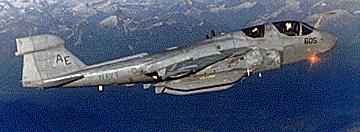 Following the transition from the EA-6A aircraft to the EA-6B, Marine Tactical Electronic Warfare Squadron 2 (VMAQ-2) continued to provide detachments to Carrier Air Wing Five on board the USS Midway. In 1980 VMAQ-2 completed its assignment aboard the Midway and began shore-based rotations with the 1st Marine Aircraft Wing in Iwakuni, Japan. Detachments were subsequently sent back to sea duty aboard the USS Saratoga and USS America. Marine Prowlers supported joint operations against Libya in 1986 from the carrier.
Following the transition from the EA-6A aircraft to the EA-6B, Marine Tactical Electronic Warfare Squadron 2 (VMAQ-2) continued to provide detachments to Carrier Air Wing Five on board the USS Midway. In 1980 VMAQ-2 completed its assignment aboard the Midway and began shore-based rotations with the 1st Marine Aircraft Wing in Iwakuni, Japan. Detachments were subsequently sent back to sea duty aboard the USS Saratoga and USS America. Marine Prowlers supported joint operations against Libya in 1986 from the carrier.
During Operations Desert Storm and Desert Shield VMAQ-2 had one detachment (six aircraft) deployed in Japan and the remainder of the squadron (12 aircraft) deployed to the Persian Gulf. The Reserve squadron, VMAQ-4 (six aircraft), transitioned from the EA-6A to the EA-6B and subsequently relieved the detachment in Japan. During Desert Shield the squadron flew 936 sorties for over 2100 hours. Marine Prowlers flew 495 combat missions totaling 1622 hours, supporting the full spectrum of joint and combined missions.
Effective Oct. 1, 1992, the Marine Prowler community reorganized its structure. VMAQS are now structured into four active force squadrons (VMAQ-1, 2, 3, 4). Each squadron now has at least five aircraft. This restructuring provides the flexibility necessary for continuing to support peacetime requirements, as well as the capacity to concurrently assign Marine EA-6B forces to commanders in different areas of operation. One squadron was assigned to Carrier Airwing One on USS America (CV 66) in FY95, while the others continue to support the Unit Deployment Program and CINC contingency requirements.
Upgrades
The EA-6B Block 89A is supposed to IOC in 2000. The upgrade promises to be a substantial improvement over previous Block aircraft. The communication system is designed around two ARC-210's in the front and one ARC-182 in the back. In addition to being capable of the same communication frequency ranges as the ARC-182, the ARC-210's also have integrated HAVEQUICK and SINCGARS functions. Another really nice feature about the ARC-210's is that they are integrated with the control display navigation unit (CDNU) so that you can control the radios (all three of them) from a "Radio" page on the CDNU. Navigation system upgrades are also very substantial. The primary navigation sensor is the Litton CN-1649(V)4/ASN-172 Embedded GPS/INS (EGI).This unit combines the Litton LN-100G strapdown inertial unit with a GPS receiver. The result is that the system, or the aircrew, can select from four possible navigation solutions from this one unit. You can select a pure inertial, GPS, filtered inertial, or filtered inertial solution with GPS aiding. Most of the testing used the filtered inertial solution with GPS aiding, called Blended/Coupled, because it was typically the most accurate. This mode allowed the Prowler to navigate with an accuracy of about 16 m (52 ft), a big improvement! The ASN-130 is still in the aircraft as the secondary attitude and navigation source with all the capability it has always had. The 89A also features an improved databus structure that allows the CDNU to integrate many things like the radios, RADAR cursor, both navigation sensors, route control, HARM control, WRA BIT, and current navigation and attitude information.
The Multimission Advanced Tactical Terminal (MATT) and Improved Data Modem (IDM), a program originally called the Connectivity Modification, is a miniaturized, airborne UHF receiver providing detection, decryption, and correlation of contact information obtained through the TRAP, TADIXS-B, and TIBS broadcasts. The contact data arrives in near-real-time from national asset sensors and can give an over-the-horizon look at both friendly and hostile platforms and emitters. The MATT is a single WRA installed above the port wing shoulder, with associated satellite receive antenna and filter, replacing the ADF antenna on the �turtleback.� The IDM is a device that formats digital data for transmission using the existing ARC-159, radio No. 3. In a perfect world, incoming MATT data can be examined, selected, and digitally transmitted using the IDM to F-16's as HARM target packages. Information can also be exchanged with other IDM-equipped EA-6B's or Rivet Joint aircraft.
The USQ-113 is controlled primarily by the same ruggedized laptop computer that is used for the MATT/IDM systems, or by an improved operator control panel in the front cockpit.
The EA-6B will begin retirement in the 2010 timeframe, after a career that exceeded 40 years of deployments in support of USN, USMC, and USAF strike forces. As of early 2000, Defense Department planning for replacing the EA-6B Prowler include a scheme under which the Navy would buy an F/A-18G "Growler" -- an F/A-18E/F modified for escort and close-in jamming. The Air Force would provide standoff jamming with modified EB-52s or EB-1s, and close-in jamming with unmanned air vehicles such as the Northrop Grumman Global Hawk or General Atomics Predator.
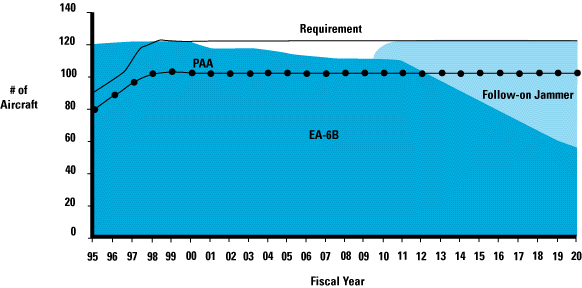
Specifications | |
| Manufacturer: | Grumman Aircraft Corporation |
| Power plant: | Two Pratt & Whitney J52-P408 turbojet engines |
| Thrust: | 11,200 pounds (4,767 kilograms) per engine |
| Length: | 59 feet (17.98 meters) |
| Height: | 15 feet (4.57 meters) |
| Wing span: | 53 feet (16.15 meters) |
| Speed: | Maximum .99 mach; cruise .72 mach |
| Ceiling: | 40,000 feet - maximum (12,186 meters) 37,600 feet - Service ceiling |
| Performance | 2,750 ft - Minimum take-off distance 2,185 ft - Minimum landing distance |
| Weight | 33,600 lbs - Empty 61,500 lbs - Maximum TOGW (27,921 kilograms) 15,422 lbs - Internal fuel 10,000 lbs - External fuel 4,000 lbs - External fuel (typical) |
| Range: | Unrefueled in combat configuration: 850 nautical miles (977.5 miles) Ferry range (5 drop tanks) 1,747 nm Refueled: unlimited (crew fatigue factor - approximately 8 hours) |
| Armament: | ALQ-99 Tactical Jamming System (TJS); High Speed Anti-Radiation Missile (HARM) |
| Sensors: | ALQ-99 On-board System (OBS) |
| Crew: | 4 |
| Introduction date: | ICAP configuration, 1977; ICAP II configuration, 1984; ICAP III configuration, 2005-2006 |
| Unit Replacement Cost: | $52,000,000 |
| Inventory: | 100 PAA 120 total |
| VRML 3-D Model |
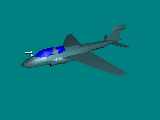 EA-6B Prowler VRML by Soji Yamakawa |

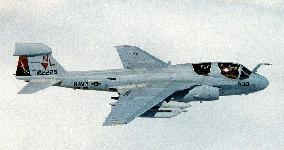
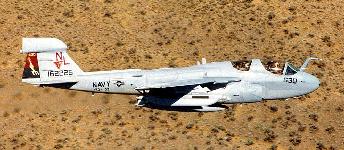
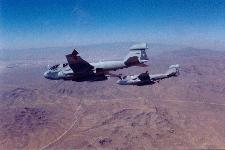
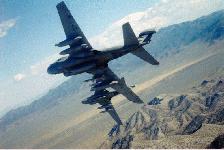
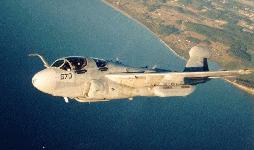

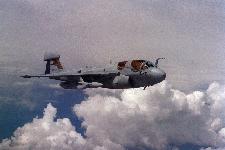

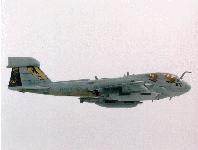
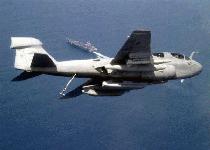
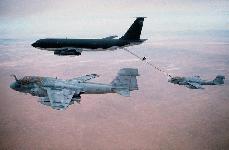
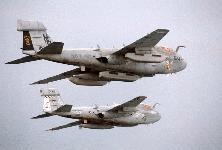
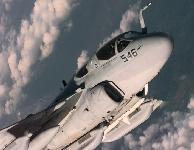

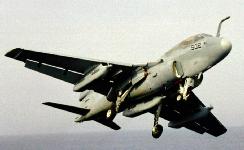
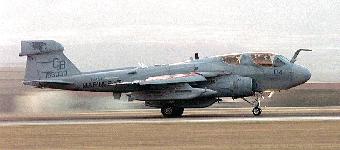
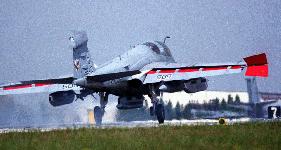
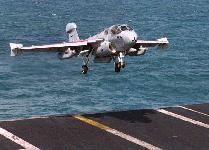
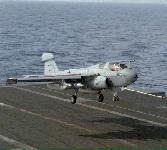
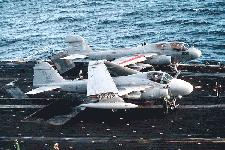
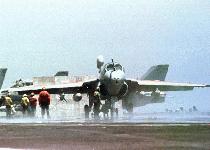
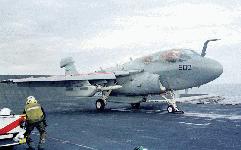
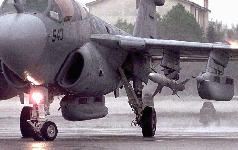
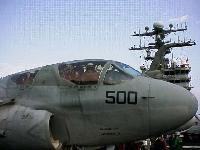
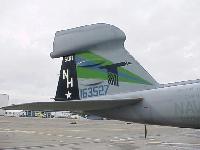
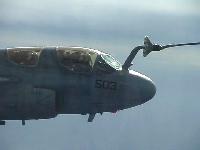
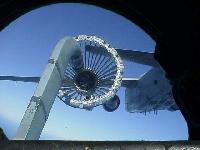

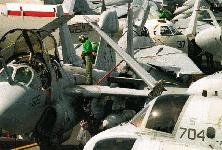
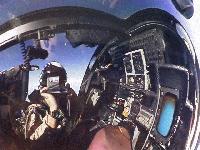






No comments:
Post a Comment